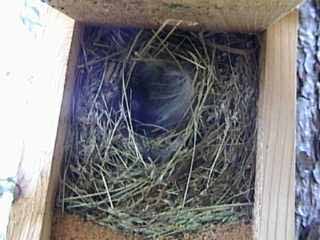Activities
![]() Charting eggs ele
Charting eggs ele
![]() All about Birds ele/ms
All about Birds ele/ms
![]() Frayer Model Birds - doc. | pdf
Frayer Model Birds - doc. | pdf
![]() Collecting data ele/ms
Collecting data ele/ms
![]() Life Cycles ele/ms
Life Cycles ele/ms
![]() Variables ele/ms/hs
Variables ele/ms/hs
![]() Feather Facts ms/hs
Feather Facts ms/hs
![]() Scientific Thinking ele/ms/hs
Scientific Thinking ele/ms/hs
![]() Systems & Controls ms/hs
Systems & Controls ms/hs
![]() Science Journal Entry ms/hs
Science Journal Entry ms/hs
![]() Make Puzzle ele/ms/hs
Make Puzzle ele/ms/hs
![]() Ecology Vocabulary ms/hs
Ecology Vocabulary ms/hs
![]() Classification ms/hs
Classification ms/hs
Other Nestbox residents:
English Sparrow Nest Photo
Peek in a English Sparrow's nest box:

There were many clues this is an English Sparrow's nest.
One - there is a canopy of grasses over the top of the cup.
Two - there are feathers and trash in the nest. English Sparrows will add bits of plastic trash to their nest.
Three - there were several white, with brown speckles, eggs in the nest. Finally, two english sparrows were observed coming and going from the box.
English Sparrows (Passer domesticus) or House Sparrows as they are commonly called are a non-native bird. They were released in America around 1850. They were released in hopes of them eating bugs. Ironically, they are primarily seed eaters.
Later it was discovered that they aggressively compete with native, cavity-nesting birds like bluebirds. Male sparrows have been observed destroying eggs, killing nestlings, and sometimes killing incubating females in an effort to take over an occupied nest box. This competition for nesting sites has contributed to the decline of the bluebird.
Many bluebirders do not allow English Sparrows to successfully nest in their nest boxes.
English sparrows are an unwelcome, nonnative pest bird.
To learn more about house sparrows, visit Cornell University's bird web site: http://www.allaboutbirds.org/NetCommunity/Page.aspx?pid=1189
![]() Other potential nest box inhabitants:
Other potential nest box inhabitants:
BirdSleuth: Investigating Evidence - free materials from Cornell University
This work is licensed under a Creative Commons Attribution-NonCommercial 2.5 License.
Aligned with the Pennsylvania Academic Standards for Science & Technology, Reading, Writing, Ecology & Environment, Mathematics